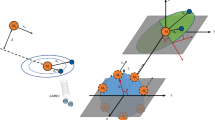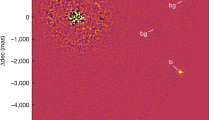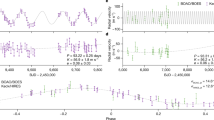Abstract
Nearly half the exoplanets found within binary star systems reside1 in very wide binaries with average stellar separations greater than 1,000 astronomical units (one astronomical unit (au) being the Earth–Sun distance), yet the influence of such distant binary companions on planetary evolution remains largely unstudied. Unlike their tighter counterparts, the stellar orbits of wide binaries continually change under the influence of the Milky Way’s tidal field and impulses from other passing stars. Here we report numerical simulations demonstrating that the variable nature of wide binary star orbits dramatically reshapes the planetary systems they host, typically billions of years after formation. Contrary to previous understanding2, wide binary companions may often strongly perturb planetary systems, triggering planetary ejections and increasing the orbital eccentricities of surviving planets. Although hitherto not recognized, orbits of giant exoplanets within wide binaries are statistically more eccentric than those around isolated stars. Both eccentricity distributions are well reproduced when we assume that isolated stars and wide binaries host similar planetary systems whose outermost giant planets are scattered beyond about 10 au from their parent stars by early internal instabilities. Consequently, our results suggest that although wide binaries eventually remove the most distant planets from many planetary systems, most isolated giant exoplanet systems harbour additional distant, still undetected planets.
This is a preview of subscription content, access via your institution
Access options
Subscribe to this journal
Receive 51 print issues and online access
$199.00 per year
only $3.90 per issue
Buy this article
- Purchase on Springer Link
- Instant access to full article PDF
Prices may be subject to local taxes which are calculated during checkout



Similar content being viewed by others
References
Roell, T., Neuhäuser, R., Seifahrt, A. & Mugrauer, M. Extrasolar planets in stellar multiple systems. Astron. Astrophys. 542, A92 (2012)
Desidera, S. & Barbieri, M. Properties of planets in binary systems. The role of binary separation. Astron. Astrophys. 462, 345–353 (2007)
Heggie, D. C. & Rasio, F. A. The effect of encounters on the eccentricity of binaries in clusters. Mon. Not. R. Astron. Soc. 282, 1064–1084 (1996)
Jiang, Y.-F. & Tremaine, S. The evolution of wide binary stars. Mon. Not. R. Astron. Soc. 401, 977–994 (2010)
Oort, J. H. The structure of the cloud of comets surrounding the Solar System and a hypothesis concerning its origin. Bull. Astron. Inst. Neth. 11, 91–110 (1950)
Heisler, J. & Tremaine, S. The influence of the galactic tidal field on the Oort comet cloud. Icarus 65, 13–26 (1986)
Kaib, N. A. & Quinn, T. Reassessing the source of long-period comets. Science 325, 1234–1236 (2009)
Adams, F. C. & Laughlin, G. Constraints on the birth aggregate of the Solar System. Icarus 150, 151–162 (2001)
Zakamska, N. L. & Tremaine, S. Excitation and propagation of eccentricity disturbances in planetary systems. Astron. J. 128, 869–877 (2004)
Chambers, J. E., Quintana, E. V., Duncan, M. J. & Lissauer, J. J. Symplectic integrator algorithms for modeling planetary accretion in binary star systems. Astron. J. 123, 2884–2894 (2002)
Lissauer, J. J. Planet formation. Annu. Rev. Astron. Astrophys. 31, 129–172 (1993)
Wright, J. T. et al. Ten new and updated multiplanet systems and a survey of exoplanetary systems. Astrophys. J. 693, 1084–1099 (2009)
Jurić, M. & Tremaine, S. Dynamical origin of extrasolar planet eccentricity distribution. Astrophys. J. 686, 603–620 (2008)
Ford, E. B. & Rasio, F. A. Origins of eccentric extrasolar planets: testing the planet-planet scattering model. Astrophys. J. 686, 621–636 (2008)
Malmberg, D. & Davies, M. B. On the origin of eccentricities among extrasolar planets. Mon. Not. R. Astron. Soc. 394, L26–L30 (2009)
Raymond, S. N., Armitage, P. J. & Gorelick, N. Planet-planet scattering in planetesimal disks. II. Predictions for outer extrasolar planetary systems. Astrophys. J. 711, 772–795 (2010)
Kozai, Y. Secular perturbations of asteroids with high inclination and eccentricity. Astron. J. 67, 591–598 (1962)
Holman, M., Touma, J. & Tremaine, S. Chaotic variations in the eccentricity of the planet orbiting 16 Cygni B. Nature 386, 254–256 (1997)
Wu, Y. & Murray, N. Planet migration and binary companions: the case of HD 80606b. Astrophys. J. 589, 605–614 (2003)
Fabrycky, D. & Tremaine, S. Shrinking binary and planetary orbits by Kozai cycles with tidal friction. Astrophys. J. 669, 1298–1315 (2007)
Marois, C., Zuckerman, B., Konopacky, Q. M., Macintosh, B. & Barman, T. Images of a fourth planet orbiting HR 8799. Nature 468, 1080–1083 (2010)
The Microlensing Observations in Astrophysics (MOA) Collaboration & The Optical Gravitational Lensing Experiment (OGLE) Collaboration. Unbound or distant planetary mass population detected by gravitational microlensing. Nature 473, 349–352 (2011)
Eggenberger, A. et al. The impact of stellar duplicity on planet occurrence and properties. I. Observational results of a VLT/NACO search for stellar companions to 130 nearby stars with and without planets. Astron. Astrophys. 474, 273–291 (2007)
Raghavan, D. et al. Two suns in the sky: stellar multiplicity in exoplanet systems. Astrophys. J. 646, 523–542 (2006)
Mugrauer, M. et al. A search for wide visual companions of exoplanet host stars: the Calar Alto survey. Astron. Nachr. 327, 321–327 (2006)
Jones, H. R. A. et al. High-eccentricity planets from the Anglo-Australian Planet Search. Mon. Not. R. Astron. Soc. 369, 249–256 (2006)
Naef, D. et al. HD 80606 b, a planet on an extremely elongated orbit. Astron. Astrophys. 375, L27–L30 (2001)
Innanen, K. A., Zheng, J. Q., Mikkola, S. & Valtonen, M. J. The Kozai mechanism and the stability of planetary orbits in binary star systems. Astron. J. 113, 1915–1919 (1997)
Batygin, K., Morbidelli, A. & Tsiganis, K. Formation and evolution of planetary systems in presence of highly inclined stellar perturbers. Astron. Astrophys. 533, A7 (2011)
Kaib, N. A., Raymond, S. N. & Duncan, M. J. 55 Cancri: a coplanar planetary system that is likely misaligned with its star. Astrophys. J. 742, L24 (2011)
Acknowledgements
We thank J. Chambers and R. Roškar for discussions. This work was funded by a CITA National Fellowship and Canada’s NSERC. S.N.R. thanks the PNP programme of CNRS and the NASA Astrobiology Institute’s Virtual Planetary Laboratory team. Our computing was performed on the SciNet General Purpose Cluster at the University of Toronto.
Author information
Authors and Affiliations
Contributions
N.A.K. performed the simulations and analysis and was the primary writer of this paper. S.N.R. and M.D. helped initiate the project and advised on simulations and analysis.
Corresponding author
Ethics declarations
Competing interests
The authors declare no competing financial interests.
Supplementary information
Supplementary Information
This file contains Supplementary Methods, a Supplementary Discussion, Supplementary Table 1 and Supplementary Figures 1-11. (PDF 430 kb)
Rights and permissions
About this article
Cite this article
Kaib, N., Raymond, S. & Duncan, M. Planetary system disruption by Galactic perturbations to wide binary stars. Nature 493, 381–384 (2013). https://doi.org/10.1038/nature11780
Received:
Accepted:
Published:
Issue Date:
DOI: https://doi.org/10.1038/nature11780
This article is cited by
Comments
By submitting a comment you agree to abide by our Terms and Community Guidelines. If you find something abusive or that does not comply with our terms or guidelines please flag it as inappropriate.



